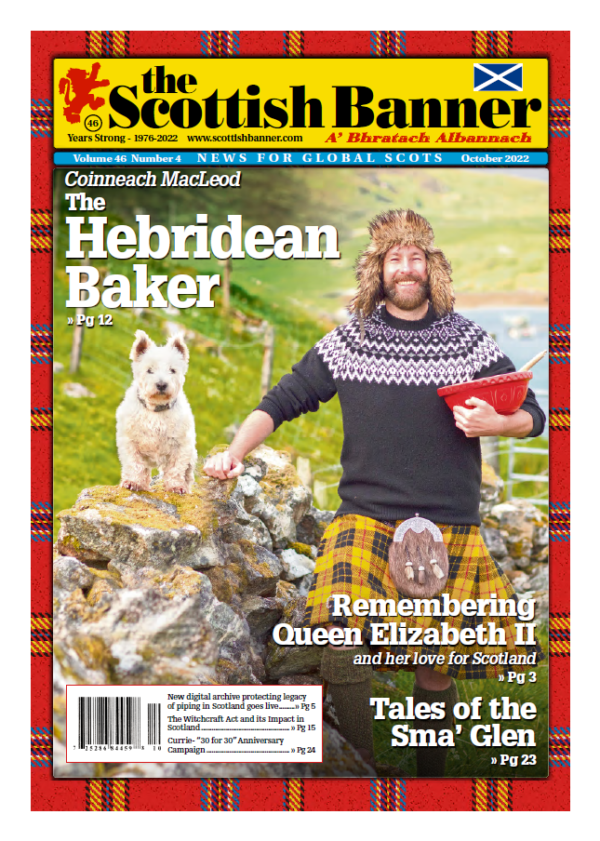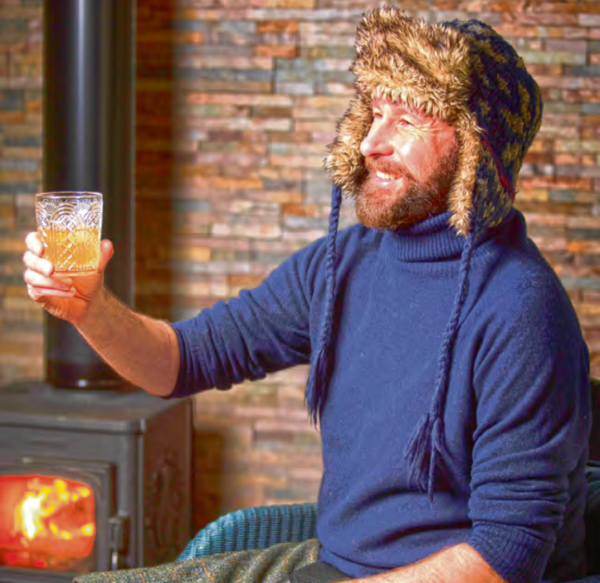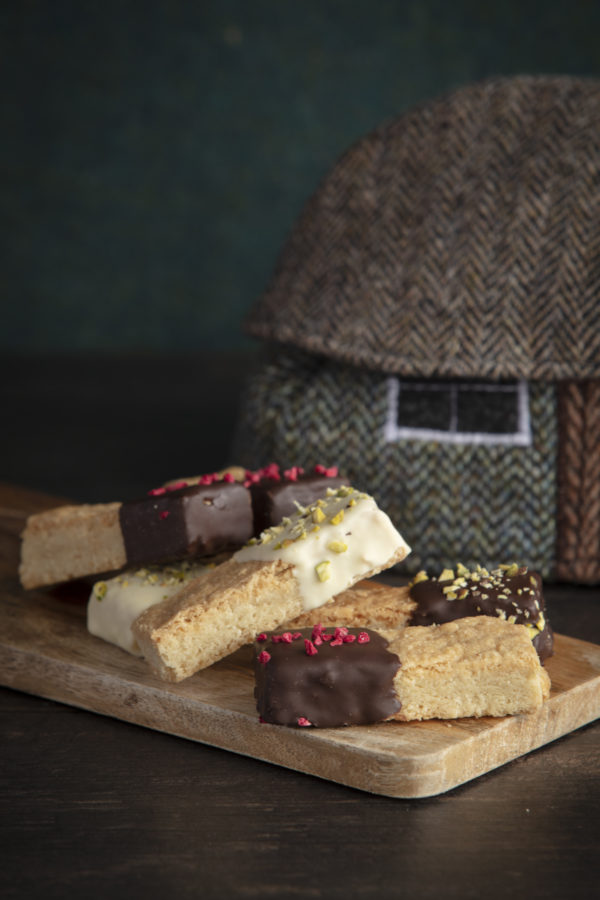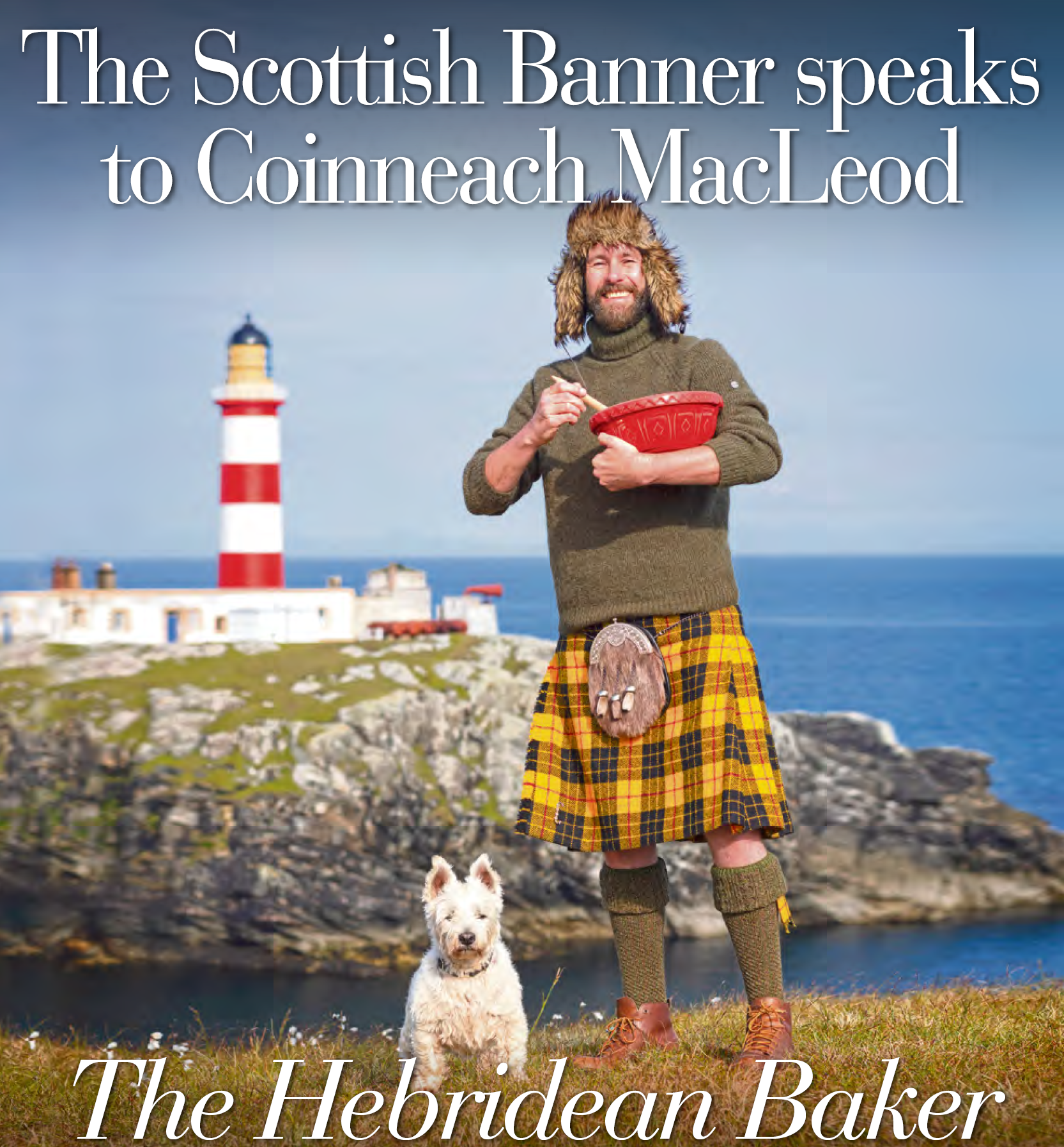The Scottish Banner speaks to Coinneach MacLeod, The Hebridean Baker
Coinneach you began doing TikTok videos during the pandemic, would you ever have imagined that would lead to you having millions of views and becoming an author and internet celebrity?
I had dreamed for some time of creating a storyline around the Hebrides, our food, our identity and our culture. I had gone on to TikTok and found it to be one of the most creative communities I had ever engaged with, and it really inspired me to start creating my own content. The genuine reason I really started was that I was over at my Aunt Bellag’s house, who lives in the next village, and we were sitting by the stove, and she had Clootie Dumpling bubbling away. She was telling me the story of her wedding day, which had been 70 years ago that day, and she had made Clootie Dumpling on her wedding day. As she shared this story and made the cake, I thought I really want people on the island to know these stories and make sure we don’t forget the traditions we have. I really did not want people on the island to lose these stories and when I started all this it really was for people on the island, and I never imagined it would be something people across the world would enjoy. I am now on 21 million people who have watched my recipes and video stories, and I definitely know there is not 21 million people on the island of Lewis!
It has been an amazing experience and brought great opportunities for me. The thing however that has been most joyous has been talking about Scotland and the Hebrides and our culture, identity, the Gaelic language and of course our food culture. I think I am one of the luckiest people alive to be able to do that.
You draw on much traditional Scottish recipes and also your own family’s favourites. How important is it for you to share and promote Scottish cooking traditions?
It really seems to have resonated with people. A lot of people over these last couple of years have been looking for a sense of community and belonging. There is a beautiful word in Gaelic called cianalas, and while it does not have an actual english translation people sort of translate it to homesickness, but it is more of a longing for somewhere, somewhere you belong and sometimes it’s even for somewhere you have never been. When I did my US book tour, I noticed many people who were very proud of their Scottish heritage or ancestry, particularly if they had Highland or Hebridean identity, and they may have not been to visit but reading my stories and recipes there was a kinship they really enjoyed. That was an unexpected bonus for me, and it has centred what is really important, for me that is making sure that Scottish folk around the world are able to feel proud of their produce, recipes, flavours and stories.
I try and picture what someone will do when they are baking one of my recipes, especially the older ones, which have a story connected to them. There is a wonderful Shetland shortbread recipe in my first book called a Bride’s Bun, which is traditionally made by the mother of the bride on the day of her daughter’s wedding. Tradition states when the bride comes home from the wedding, and rather than giving her a big hug, the mother smashes the shortbread over the bride’s head which is very good luck not only for the bride, but guests try and catch a piece of the shortbread is it hits the ground. You are meant to put the shortbread under your pillow and have sweet dreams. A lot of my traditional recipes have story lines that go with them and that is one of my favourite things to bring across in the books.

You share not just recipes, but your cookbooks and social media also celebrate the incredible Scottish landscape, music, travel tips and the Gaelic language. How important is it for you to be an ambassador for brand Scotland and share what an incredible country it is?
For me this has been the biggest part is to promote Scotland and our identity. I have been so honoured to do campaigns for VisitScotland and for the Outer Hebrides, our island tourist board. I have had several ‘pinch me’ moments when I have been representing Scotland. Soon I am off to Las Vegas to represent Scotland at a baking expo which is incredible. It makes me proud that I can represent Scotland positively. In everything I do I do not try and make the Hebrides, or Scotland, into this picture-perfect location in my video you will see the rain and the darkness of the winter nights and working hard on the land. I portray a real Scotland in the most positive way as possible.
Your lovely Westie Seòras features in your videos and books. How great is it to have him by your side and could he be just as popular as your recipes?
Yes, Seòras is the Gaelic for George, and honestly, I think Seòras has become Scotland’s most famous dog. He is just loved across the world and even when I was recently in Cape Breton, which was a real dream of mine to go to Nova Scotia, everywhere I went the first question was “Did you bring Seòras?”
I am sure there is a core fanbase out there who go through my recipe videos just to get to the next Seòras adventure.
You recently toured Canada and the US to promote your cookbook. How was it for you to connect with international Scots?
It was so humbling to arrive at the book events, in the US I did 12 cities in 13 days, and each night was sold out and it was a wonderful mix of people that had stumbled upon my page and started to enjoy my content but more than anything else it was people with Scottish heritage and ancestry or were people who were from Scotland and just missing it so much and seeing my recipes just gave them so much joy. Everywhere we went we met wonderful people and could not help but smile as I travelled around. I am already booked to go back for a second book tour at the end of January.
You come from the Isle of Lewis, the northernmost island in the Outer Hebrides, can you tell us what life is like living in such a remote place? Also, any tips for those who have yet to visit this part of Scotland?
The word remote is one we try and not use on the island and in our identity. That comes from a story when the first First Minister Donald Dewar visited the island, and he asked an older lady working on her potatoes in her croft “Don’t you feel remote?” and she replied, “Remote from where?” and I thought was very poignant that he thought people may feel remote from Edinburgh or Glasgow. We do feel far away, when you have to get a ferry and then a six-hour drive, you definitely feel far away. We do feel where we live is so wonderful that we do not feel we are missing out or remote in anyway. To get to Lewis is an adventure and taking the ferry makes you feel like you are going somewhere different, even though you can fly I do recommend you get a car and take the ferry.
Lewis and Harris have the most wonderful mix of historical aspects, as well as a flourishing food scene. It is impossible not to come here and not go to the 5,000-year-old Callanish Standing Stones and Gearrannan Blackhouse Village, which is a re-creation of the stone thatched cottage homesteads that families, and the animals, lived in until the 1950’s. We also have some of the most beautiful beaches in the world here from Luskentyre to Bosta beach they really are beautiful. There is definitely a new energy on the islands, particularly with the food scene. I was lucky to recently do a foodie trail from Barra to Lewis stopping at restaurants, cafes and seafood shacks on all the islands of the Outer Hebrides, and yes, I may have put on a few pounds, but I had the best time.
Is it true you live off the grid and your home is only accessible by canoe?
Myself and my partner Peter are lucky enough to have two homes, our main home is on Lewis. Peter is from Oban on the west coast and his father is from the island of Seil and his mother from Mull and his father had a dream to build somewhere that he could sit at his window and look at the island he was born on and the island his wife was born on. There is a lifestyle in Scotland called hutting, a concept of having a place to go to rear your animals or grow vegetables and the responsibility of hutting is that it must be off grid and you can’t have running water or connected to any electric grid. We must canoe for 25 minutes to get there, but it is the most idyllic life, and we spend about half our year there living off the grid. We absolutely love it, and it is something we will continue to do long term in the future.

You are obviously a very proud Hebridean, but also proud of your Viking heritage, can you tell us more?
As many readers may well know the Outer Hebrides were part of a number of the Scottish islands that were part of the Norse Kingdom. We were part of what is now called Norway for 400 years. The Norse settled well into the Hebrides and brought a lot of good things to the islands. The input of the language of old Norse, has been used in our Gaelic in the Outer Hebrides. Norse has influenced our Gaelic for example I am from the village of Cromore and crò is the old Norse word for cattle and mòr is the Gaelic word for big. Even our accents are different, and I can be in the central belt of Scotland and be asked if I am Norwegian or Icelandic. My new cookbook coming out in late January internationally also has a chapter on Scandinavian recipes with Nordic bakes.
Something that is still fascinating with the relationship between Scotland and Norway is that in 1266 Scotland bought the Hebrides from Norway and they paid 4,000 merks for them. It is an obligation of the Scottish Government to pay the Norwegian Government £100 per year to keep the Hebrides as part of Scotland. I always have a feeling that one day I will wake up and find out they have forgotten to pay, and we are part of Norway again. I don’t know if Nicola Sturgeon would let that happen and I hope she doesn’t!
Some may be surprised to learn you have had a role as a development officer in sport, what has that been like?
I have always loved sports and have worked in sport for nearly 20 years. The thing I was most proud of was I used to work for the Scottish National Team in football and walking off a plane to go to an away match with your national team, there is nothing prouder. Hearing your national anthem being played in Spain, Sweden or Serbia is absolutely amazing. In development work I travel overseas to developing countries to help professionalise the sport and the organisation of the sport which involves working with governments and different organisations. I am doing that role less as The Hebridean Baker is definitely a full-time life now.
You will be performing at this month’s Royal National Mòd in Perth, can you tell us what you will be doing?
I will be singing in the duet competition at the Mòd with my partner Peter, we won it four years ago and last year came second. Second place is brilliant because you get the confidence that people think you are OK, but do not need to do the formalities of being first like interviews etc. I don’t know anyone who wants to come second but we would be happy with that again as we can sing and then head off to the pub!
This year we will be performing the Gaelic version of Auld Lang Syne, which has never been performed at the Mòd before in its 130-year history.
The Hebridean Baker: Recipes and Wee Stories from the Scottish Islands is now available and The Hebridean Baker: My Scottish Island Kitchen is now out in the UK and being released internationally in January. For more details see: www.hebrideanbaker.com
From the new book Hebridean Baker: My Scottish Island Kitchen

Shortbread Dips – makes a dozen
There are three traditional ways to serve shortbread – petticoat tail, rounds and fingers. These fingers dipped in chocolate still have the butteriness of traditional shortbread, with that extra indulgence given by the white and dark chocolate. The shortbread biscuit has been made in Scotland for hundreds of years. However, it is widely regarded that it came to prominence thanks to Mary, Queen of Scots. She fell in love with the shortbread served by her French chefs and from then on, it became the iconic Scottish biscuit we all adore today.
Ingredients:
300g soft butter
125g golden caster sugar
300g plain flour
50g cornflour
½ tsp fine sea salt
150g dark chocolate
150g white chocolate
2 tbsp chopped pistachios
2 tbsp freeze-dried raspberries
Method:
Preheat the oven to 170°C, fan 150°C. Grease a 20cm square baking tin and line the base and sides with baking parchement.
Cream your butter and sugar in a bowl until lightly coloured and fluffy.
Add in both the flours plus the salt and stir until it begins to come together, though take care not to overwork the dough. Bring the dough together with your hands and press the mixture into the prepared tin. Flatten the surface of the shortbread with the back on a spoon and use a fork to prick marks along the length of the fingers.
Bake for 45 until pale golden. Remove from the oven, and with a knife, mark lines where you are going to cut the shortbread. Leave to cool in the tin.
Melt the dark and white chocolate separately in heatproof bowls set over a pan of gently simmering water. Take each of your shortbread fingers and use a teaspoon to coat one third with the chocolate. Sprinkle pistachios or freeze dried raspberries over the chocolate end and allow to set. Serve with a hot cuppa or they will keep in an airtight container for up to four days.
All images courtesy of Susie Lowe.

